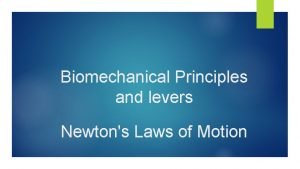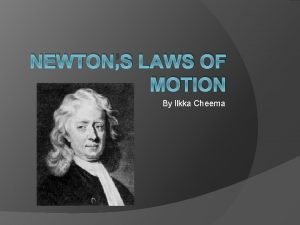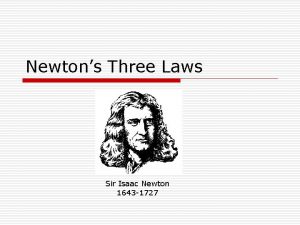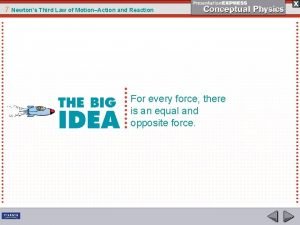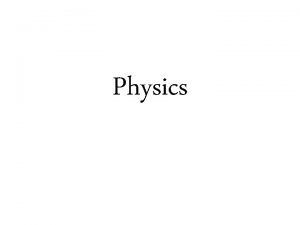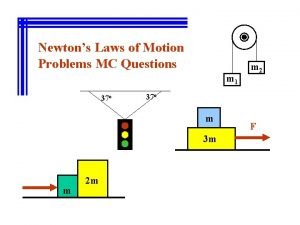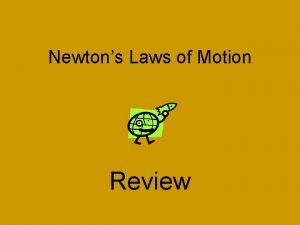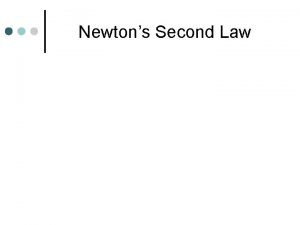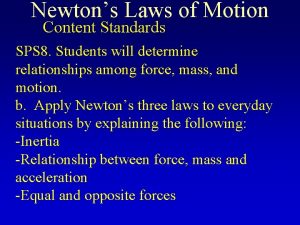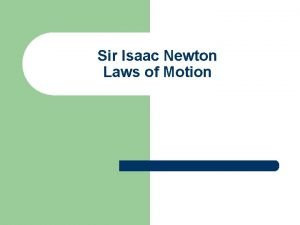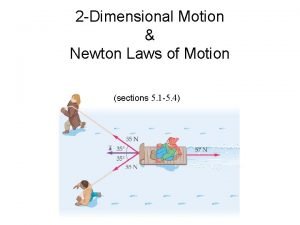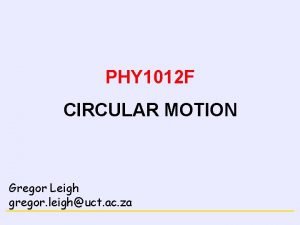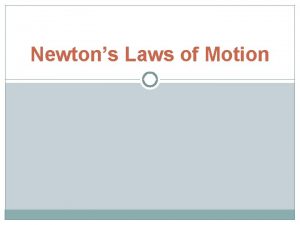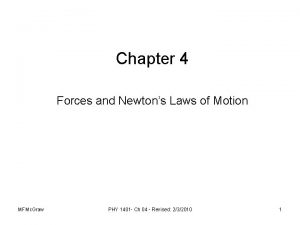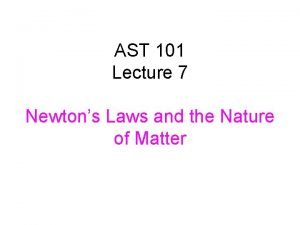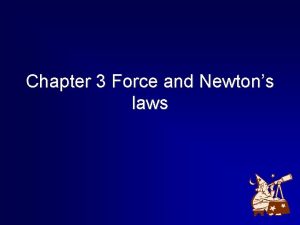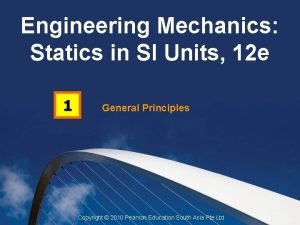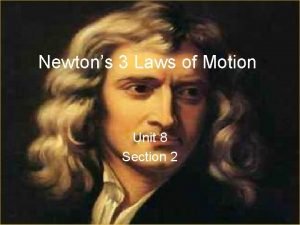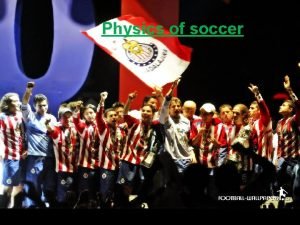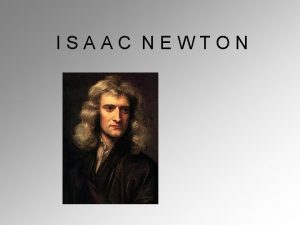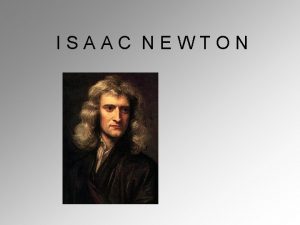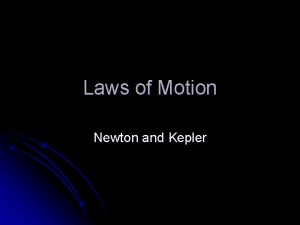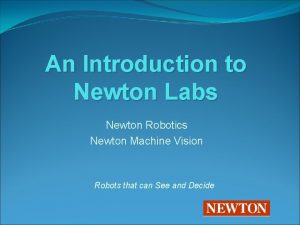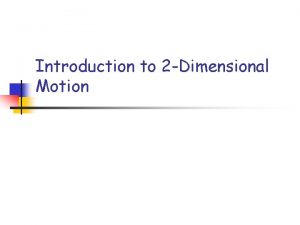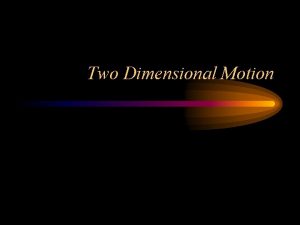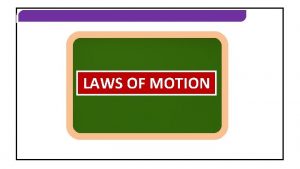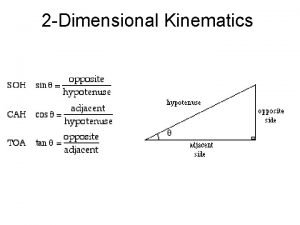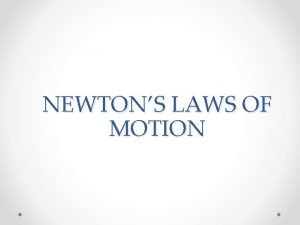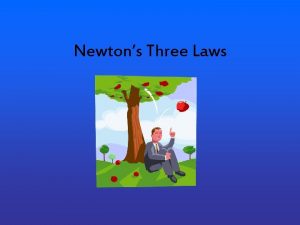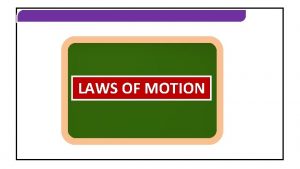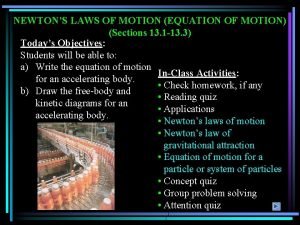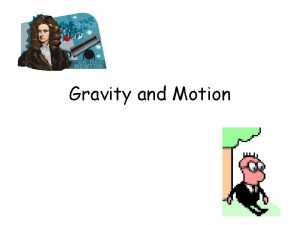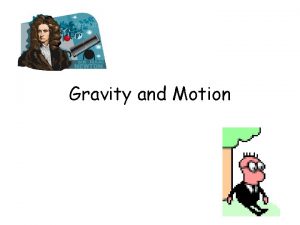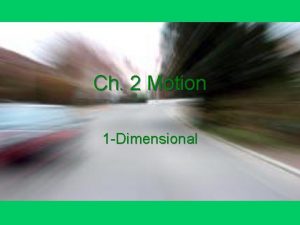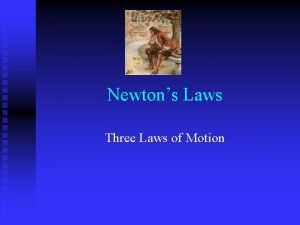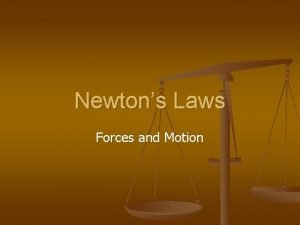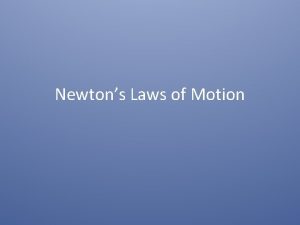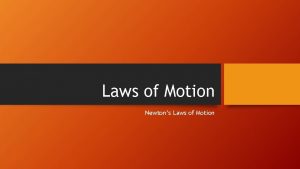2 Dimensional Motion Newton Laws of Motion sections






































- Slides: 38

2 -Dimensional Motion & Newton Laws of Motion (sections 5. 1 -5. 4)

Kinematics: Assumptions, Definitions and Logical Conclusions What have we done so far? • Defined displacement, velocity, acceleration (also position, distance, speed). . . • Defined scalers (like speed) and vectors (like velocity) • Laid out assumptions about free-fall • noticed that 2 -dimensional motion is really just two, simultaneous, 1 -dimensional motions. Used this to shoot a monkey, range out a small cannon, etc. This wasn’t physics. This was preparing the language needed to talk about physics. 2

Newton’s Laws How can we consistently and generally describe the way objects move and interact? 3

Isaac Newton 1643 -1727 1702 portrait Newton in a 1689 by Godfrey Kneller

Nature and nature's laws lay hid in night; God said "Let Newton be" and all was light. Newton’s epitaph, Alexander Pope I do not know what I may appear to the world, but to myself I seem to have been only like a boy playing on the sea-shore, and diverting myself in now and then finding a smoother pebble or a prettier shell than ordinary, whilst the great ocean of truth lay all undiscovered before me. from a memoir by Newton 5

Force: push or pull Force is a vector – it has magnitude and direction 6

Mass is the measure of how hard it is to change an object’s velocity. Mass can also be thought of as a measure of the quantity of matter in an object. 7

Newton’s First Law of Motion If you stop pushing an object, does it stop moving? Only if there is friction! In the absence of any net external force, an object at rest will remain at rest. In the absence of any net external force a moving object will keep moving at a constant speed in a straight line. This is also known as the Law of Inertia. 8

Inertia 9

Newton’s First Law A hockey puck slides on ice at constant velocity. What is the net force acting on the puck? a) more than its weight b) equal to its weight c) less than its weight but more than zero d) depends on the speed of the puck e) zero

Newton’s First Law A hockey puck slides on ice at constant velocity. What is the net force acting on the puck? a) more than its weight b) equal to its weight c) less than its weight but more than zero d) depends on the speed of the puck e) zero The puck is moving at a constant velocity, and therefore it is not accelerating. Thus, there must be no net force acting on the puck. Follow-up: Are there any forces acting on the puck? What are they?

Newton’s First Law You put your book on the a) a net force acted on it bus seat next to you. b) no, or insufficient, net force acted on it When the bus stops c) it remained at rest suddenly, the book slides forward off the seat. Why? d) it did not move, but only seemed to e) gravity briefly stopped acting on it 12

Newton’s First Law You put your book on the a) a net force acted on it bus seat next to you. b) no, or insufficient, net force acted on it When the bus stops c) it remained at rest suddenly, the book slides forward off the seat. Why? d) it did not move, but only seemed to e) gravity briefly stopped acting on it The book was initially moving forward (because it was on a moving bus). When the bus stopped, the book continued moving forward, which was its initial state of motion, and therefore it slid forward off the seat.

Calibrating force Two equal weights exert twice the force of one; this can be used for calibration of a spring: 14

Experiment: Acceleration vs Force Now that we have a calibrated spring, we can do more experiments. Acceleration is proportional to force: 15

Experiment: Acceleration vs Mass Acceleration is inversely proportional to mass: 16

Newton’s Second Law of Motion Acceleration is proportional to force: Acceleration is inversely proportional to mass: Combining these two observations gives Or, more familiarly, 17

Newton’s Second Law of Motion An object may have several forces acting on it; the acceleration is due to the net force: SI unit force Newton is defined using this equation as: 1 N is the force required to give a mass of 1 kg an acceleration of 1 m/s 2 18

Units of force: Newtons 19

Force of Gravity The weight of an object is the force acting on it due to gravity Weight: W = Fg = ma = mg vertically downwards Weight is not mass! Since , the weight of an object in Newtons is approximately 10 x its mass in kg adult human 70 kg 700 N ~ 160 lbs. E? R HE W There is no “conversion” from kg to pounds! (Unless you specify what planet you are assuming)

Newton’s First and Second Laws (I) In order to change the velocity of an object – magnitude or direction – a net force is required. (II) 21

Inertial Reference Frames (I) In order to change the velocity of an object – magnitude or direction – a net force is required. (II) Newton’s First and Second Laws do not work in an accelerating frame of reference An inertial reference frame is one in which the first and second laws are true. Accelerating reference frames are not inertial. Is the earth an inertial reference frame? No, but acceleration due to earth’s rotation around Its axis (0. 034 m/s 2), and due to earth’s rotation around sun (smaller) are negligible compared to g; so approximately yes.

Analyzing the forces in a system Free-body diagrams: A free-body diagram shows every force acting on an object. • Sketch the forces • Isolate the object of interest • Choose a convenient coordinate system • Resolve the forces into components • Apply Newton’s second law to each coordinate direction 23

Free-body Diagram Example of a free-body diagram: 24

Newton’s First Law A book is lying at a) there is a net force but the book has too much inertia rest on a table. The b) there are no forces acting on it at all book will remain c) it does move, but too slowly to be seen there at rest d) there is no net force on the book because: e) there is a net force, but the book is too heavy to move 25

Newton’s First Law A book is lying at a) there is a net force but the book has too much inertia rest on a table. The b) there are no forces acting on it at all book will remain c) it does move, but too slowly to be seen there at rest d) there is no net force on the book because: e) there is a net force, but the book is too heavy to move There are forces acting on the book, but the only forces acting are in the y-direction. Gravity acts downward, but the table exerts an upward force that is equally strong, so the two forces cancel, leaving no net force. 26

Newton’s Third Law of Motion Forces always come in pairs, acting on different objects: If object 1 exerts a force 2 exerts a force – on object 2, then object on object 1. These forces are called action-reaction pairs. 27

Some action-reaction pairs 28

Action-reaction pair? a) Yes b) No Newton’s 3 rd: F 12 = - F 21 action-reaction pairs are equal and opposite, but they act on different bodies 29

Newton’s Third Law of Motion Although the forces are the same, the accelerations will not be unless the objects have the same mass. Q: When skydiving, do you exert a force on the earth? Does the earth accelerate towards you? 30

31

Newton’s Third Law of Motion Contact forces: The force exerted by one box on the other is different depending on which one you push. Assume the mass of the two objects scales with size, and the forces pictured are the same. In which case is the magnitude of the force of box 1 on box 2 larger? 32

Truck on Frozen Lake A very large truck sits on a frozen lake. Assume there is no friction between the tires and the ice. A fly suddenly smashes against the front window. What will happen to the truck? a) it is too heavy, so it just sits there b) it moves backward at constant speed c) it accelerates backward d) it moves forward at constant speed e) it accelerates forward 33

Truck on Frozen Lake A very large truck sits on a frozen lake. Assume there is no friction between the tires and the ice. A fly suddenly smashes against the front window. What will happen to the truck? a) it is too heavy, so it just sits there b) it moves backward at constant speed c) it continuously accelerates backward d) it moves forward at constant speed e) it continuously accelerates forward When the fly hit the truck, it exerted a force on the truck (only for a fraction of a second). So, in this time period, the truck accelerated (backward) up to some speed. After the fly was squashed, it no longer exerted a force, and the truck simply continued moving at constant speed. Follow-up: What if the fly takes off, with the same speed in the direction 34 from whence it came?

A 71 -kg parent and a 19 -kg child meet at the center of an ice rink. They place their hands together and push. (a) Is the force experienced by the child more than, less than, or the same as the force experienced by the parent? (b) Is the acceleration of the child more than, less than, or the same as the acceleration of the parent? Explain. (c) If the acceleration of the child is 2. 6 m/s 2 in magnitude, what is the magnitude of the parent’s acceleration? 35

36

On vacation, your 1300 -kg car pulls a 540 -kg trailer away from a stoplight with an acceleration of 1. 9 m/s 2 (a) What is the net force exerted by the car on the trailer? (b) What force does the trailer exert on the car? (c) What is the net force acting on the car? 37

38
 A circular motion is one dimensional
A circular motion is one dimensional Biomechanics newton's laws
Biomechanics newton's laws Newton's 3 laws of motion examples
Newton's 3 laws of motion examples Three laws of newton
Three laws of newton Newton's 3 laws of motion
Newton's 3 laws of motion What are the newton's law of motion
What are the newton's law of motion Laws
Laws Newton's 3 laws of motion
Newton's 3 laws of motion Law of inertia
Law of inertia Three laws of motion
Three laws of motion 3 law of newton
3 law of newton Law of acceleration
Law of acceleration A person of weight 480 n stands
A person of weight 480 n stands What is newtons law
What is newtons law Newtons third law of motion
Newtons third law of motion 3 laws of motion by isaac newton
3 laws of motion by isaac newton Newtons second law example
Newtons second law example Brainpop newton's laws of motion worksheet answer key
Brainpop newton's laws of motion worksheet answer key Newton's first law example
Newton's first law example Newtown laws of motion
Newtown laws of motion Newton's laws of motion
Newton's laws of motion What are newton's 3 laws of motion in order
What are newton's 3 laws of motion in order Learning objectives for newton's laws of motion
Learning objectives for newton's laws of motion Facts about montesquieu
Facts about montesquieu Newton's laws
Newton's laws Newtons 3 rd law of motion
Newtons 3 rd law of motion 3 newton's laws
3 newton's laws Newton's law
Newton's law Forces and motion summary
Forces and motion summary Newton's laws
Newton's laws Section 3 using newtons laws
Section 3 using newtons laws First law of motion facts
First law of motion facts Newton's three laws
Newton's three laws How does newton's law of gravity extend kepler's laws
How does newton's law of gravity extend kepler's laws Newton's laws comic strip
Newton's laws comic strip Law of motion
Law of motion What are newtons laws
What are newtons laws Mewtons second law
Mewtons second law Newton's 2nd law in soccer
Newton's 2nd law in soccer

